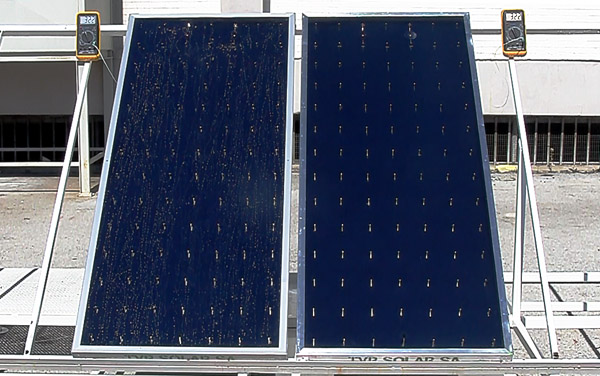
Ultra High Vacuum collectors spun off of CERN activities
Ultra High Vacuum Solar
From accellerated particles to eh, accellerating particles..
Solar thermal panels are quite common, but their yield and generated temperatures are relatively low. Non-vacuum go to about 80 Celsius, vacuum tubes go higher, but both are limited in their utility because many processes require higher temperatures.
The temperature of something depends on the speed at wich its atoms and molecules vibrate or move around. The faster they do that the hotter the material
One of the optimization problems of these systems is the loss of heat due to convection currents of the air in the collectors/panels. The heat causes the air to circulate and this helps transport heat from the hottest parts (inside) to the coldest (the outside). This limits the capacity of systems especially in winter when air temperatures are below zero.
Solar energy is high even in winter. The main problem is losing it to the air after having absorbed it. Vacuum prevents that.
There are several solutions to this problem, one is to compartmentalize the space in which air likes to move, but has adverse effects on the absorption and leads to occlusion of the collector parts of the pannel. An easier solution is to replace the air with another gas (done in double glazing) or remove it all together. This last option is tried in vacuum panels and tubes.
A good reason to try to reach higher vacuum and temperatures is that the higher the temperature differential created the more energy can be extracted
Vacuum means no air, no air pressure inside, but that stil leaves te air pressure outside, which is about 1 kg / cm2 at sealevel. The weight on one m2 is 10.000 Kg! Tis means that if you remove all air from a space the forces on it will become considerable. Because of this vacuum tube solar collectors have used tubes, cilinders, a shape able to withstand a lot of pressure. Due to the shape of tubes the area actually able to collect solar energy is limited, causing a kind of tradeoff between increased efficiency and yield/m2. Still vacuum these collectors can generate high temperatures even when it is freezing cold outside.
SRB Energy High Vacuum Solar Collector (reaches 450 Celsius)
One drawback of the common vacuum tube collector is hat the strength of the vacuum is not that great. Vacuum means no gas, and even though glass is a formidable gas barrier some will sneak in over time,and the vacuum will be lost. The higher the vacuum the faster it is lost. This has meant that leakage points have been avoided, so we have seen all glass tubes, which have the drawback of being fragile and tubular (so less space efficient).
The glass-metal seal is a key to allowing high vacuum to persist. Innovations in this regard came from CERN in Switzerland, an unlikely source as they run big particle accelerators, or maybe not so if you consider that vacuum is a big part of letting protons, electrons and such fly at near light speeds. RSB Energy was spun of off CERN. The above collector is for sale for large projects.

It now seems there is another company that uses a similar vacuum seal technology called TVPSolar in Italy (which seems unrelated to SRB Energy) that is marketing a Solar Thermal collector with a little lower max temperature 300 Celsius, which is enough for many important applications. This technology beats all other solar technologies, including fresnel, parabolic trough and vacuum tubes.
SRB Energy is ramping up production in Spain and Italy, distributing as far as Chile
Funny detail which poses a challenge with high vacuum is the fact that when you try to pump out gas from a chamber, you can reach a point where there are next to no molecules flying around anymore to separate from the low pressure space and move to the high pressure space. To find the last gas molecules (which can still amount to significant heat loss). The way to do this is by using a material that reacts strongly with the gas, something that ‘rusts’ easily. These so called ‘getter‘ materials suck up the last gas molecules in the panel. The result is a panel fit to generate heat for industrial, airco and domestic use, with output temps reaching their heights no matter how cold it is outside.

The heat market has really been married to gas for decades now, and it is natural that gas tries everything to remain attractive to this market. But solar thermal heat is now ready for continuous heat intensive industrial processes, and they don’t involve all the trouble gas is causing including international disputes, earthquakes, fracking toxicity and landscape destruction and last but not least : recurrent cost. To compete in an environment with increasing renewable capacity, the adoption of renewables is the only way, and a better, healthier and life friendly way.
If you are interested in these products in the Benelux you can contact Zonneboilerpro.nl TVPSolar or SRC Energy.